Collective Civic Petitions in Urban Neighborhoods: A Comparative Study between Two Different-Tier Chinese Cities
Abstract
1. Introduction
2. Methodology and Data
2.1. General Research Paradigm and Research Approaches
2.2. Selection of Case Cities
2.3. Data Collection and Coding
- (1)
- (2)
- (1)
- Numerical information (e.g., the number of petitions that had occurred in the two case cities from 2013 to 2015, the number of petitions that had occurred in urban neighborhoods, and the number of collective civic petitions that had occurred in urban neighborhoods);
- (2)
- Petition purpose (e.g., residents’ claims, oppositions, and other requests in the petition document);
- (3)
- Petition type (e.g., claim, protest, or hybrid);
- (4)
- Petition counterparties (e.g., state authorities, property management companies, real developer, or others);
- (5)
- Contextual information (e.g., event date, individual urban neighborhoods’ locations, the size of individual urban neighborhood, as well as the time that has elapsed since the individual urban neighborhood were built);
- (6)
- Households involvement in individual petitions (the number of families that signed the given petition).
3. Changing Trends
3.1. General Trends
3.2. Trends of Targeted Petitions
3.3. Cross-Tabulation in Targeted Petitions
4. Internal Mechanisms
4.1. Correlation Analysis
4.2. Logistic Regression
5. Spatial Mapping
5.1. Spatial Distribution
5.2. Spatial Agglomeration
6. Research Findings
6.1. Advancing Urban Civic Engagements
6.2. Internal Mechanisms within the Typology
6.3. Spatial Concentration and Agglomerations
7. Conclusions
Author Contributions
Funding
Acknowledgments
Conflicts of Interest
References
- Bian, Y.; Logan, J.R. Market transition and the persistence of power: The changing stratification system in urban China. Am. Sociol. Rev. 1996, 61, 739–758. [Google Scholar] [CrossRef]
- Adler, P.; Goggin, J. What do we mean by “civic engagement”? J. Transform. Educ. 2005, 3, 236–253. [Google Scholar] [CrossRef]
- Son, J.; Lin, N. Social capital and civic action: A network-based approach. Soc. Sci. Res. 2008, 37, 330–349. [Google Scholar] [CrossRef]
- Putnam, D. Bowling alone: America’s declining social capital. In Culture and Politics; Palgrave Macmillan: New York, NY, USA, 2000; pp. 223–234. [Google Scholar]
- Hu, K.; Chan, R. Social capital and civic engagement in urban China. Int. J. Soc. Qual. 2012, 2, 24–42. [Google Scholar] [CrossRef]
- Read, L. Democratizing the neighbourhood? New private housing and home-owner self-organization in urban China. China J. 2003, 49, 31–59. [Google Scholar] [CrossRef]
- Wu, F. The poverty of transition: From industrial district to poor neighbourhood in the city of Nanjing, China. Urban Stud. 2007, 44, 2673–2694. [Google Scholar]
- Fu, Q.; Lin, N. The Weaknesses of Civic Territorial Organizations: Civic Engagement and Homeowners Associations in Urban China. Int. J. Urban Reg. Res. 2014, 38, 2309–2327. [Google Scholar] [CrossRef]
- He, S. Homeowner associations and neighborhood governance in Guangzhou, China. Euras. Geogr. Econ. 2015, 56, 260–284. [Google Scholar] [CrossRef]
- Liu, Y.; Wu, F.; Liu, Y.; Li, Z. Changing neighbourhood cohesion under the impact of urban redevelopment: A case study of Guangzhou, China. Urban Geogr. 2017, 38, 266–290. [Google Scholar] [CrossRef]
- Zhang, L. Forced from home: Property rights, civic activism, and the politics of relocation in China. Urban Anthropol. Stud. Cult. Syst. World Econ. Dev. 2004, 33, 247–281. [Google Scholar]
- Wang, W.; Hui, L.; Terry, L. Civic engagement and citizenship development: The case of homeowners’ participation in neighborhood affairs in Beijing. Adm. Soc. 2017, 49, 827–851. [Google Scholar] [CrossRef]
- Cheng, Y.; Liang, J.; Leung, L. Social network service use on mobile devices: An examination of gratifications, civic attitudes and civic engagement in China. New Media Soc. 2015, 17, 1096–1116. [Google Scholar] [CrossRef]
- Shao, G.; Lu, J.; Wu, J. New media and civic engagement in China: The case of the Xiamen PX event. China Media Res. 2012, 8, 76–82. [Google Scholar]
- Tang, S.; Zhan, X. Civic environmental NGOs, civil society, and democratisation in China. J. Dev. Stud. 2008, 44, 425–448. [Google Scholar] [CrossRef]
- Leggett, A. Online Civic Engagement and the Anti-domestic Violence Movement in China: Shifting Norms and Influencing Law. VOLUNTAS Int. J. Volunt. Nonprofit Organ. 2017, 28, 2251–2277. [Google Scholar] [CrossRef]
- Arnstein, S.R. A ladder of citizen participation. J. Am. Inst. Plan. 1969, 35, 216–224. [Google Scholar] [CrossRef]
- Andrews, R. Civic culture and public service failure: An empirical exploration. Urban Stud. 2007, 44, 845–863. [Google Scholar] [CrossRef]
- Andrews, R. Civic engagement, ethnic heterogeneity, and social capital in urban areas: Evidence from England. Urban Affairs Rev. 2009, 44, 428–440. [Google Scholar] [CrossRef]
- Pattie, C.; Patrick, S.; Paul, W. Citizenship and civic engagement: Attitudes and behaviour in Britain. Political Stud. 2003, 51, 443–468. [Google Scholar] [CrossRef]
- Sampson, R.J.; McAdam, D.; MacIndoe, H.; Weffer-Elizondo, S. Civil society reconsidered: The durable nature and community structure of collective civic action. Am. J. Sociol. 2005, 111, 673–714. [Google Scholar] [CrossRef]
- Saegert, S. Building civic capacity in urban neighborhoods: An empirically grounded anatomy. J. Urban Affairs 2006, 28, 275–294. [Google Scholar] [CrossRef]
- Cohen, M.; Wiek, A.; Kay, B.; Harlow, J. Aligning public participation to stakeholders’ sustainability literacy—A case study on sustainable urban development in Phoenix, Arizona. Sustainability 2015, 7, 8709–8728. [Google Scholar] [CrossRef]
- Reese, A.; Rosenfeld, R.A. The Civic Culture of Local Economic Development; Sage: Thousand Oaks, CA, USA, 2002. [Google Scholar]
- De Souza Briggs, X. Democracy as Problem Solving: Civic Capacity in Communities across the Globe; MIT Press: Cambridge, CA, USA, 2008. [Google Scholar]
- Chen, A.; Partridge, M.D. When are cities engines of growth in China? Spread and backwash effects across the urban hierarchy. Reg. Stud. 2013, 47, 1313–1331. [Google Scholar] [CrossRef]
- Li, H.; Wei, Y.D.; Liao, F.H.; Huang, Z. Administrative hierarchy and urban land expansion in transitional China. Appl. Geogr. 2015, 56, 177–186. [Google Scholar] [CrossRef]
- Chen, Y.; Wu, Y. Regional economic growth and spillover effects: An analysis of China’s Pan Pearl River Delta Area. China World Econ. 2012, 20, 80–97. [Google Scholar] [CrossRef]
- Zhou, Y.; Ma, L.J. Economic restructuring and suburbanization in China. Urban Geogr. 2000, 21, 205–236. [Google Scholar] [CrossRef]
- Li, S.M.; Huang, Y. Urban housing in China: Market transition, housing mobility and neighbourhood change. Hous. Stud. 2006, 21, 613–623. [Google Scholar] [CrossRef]
- Wang, X. Governmentalities in everyday practices: The dynamic of urban neighbourhood governance in China. Urban Stud. 2016, 53, 2330–2346. [Google Scholar]
- Cai, Y. Local governments and the suppression of popular resistance in China. China Q. 2008, 193, 24–42. [Google Scholar] [CrossRef]
- Paik, W. Economic development and mass political participation in contemporary China: Determinants of provincial petition (Xinfang) activism 1994–2002. Int. Political Sci. Rev. 2012, 33, 99–120. [Google Scholar] [CrossRef]
- Kim, Y.C.; Ball-Rokeach, S.J. Community storytelling network, neighborhood context, and civic engagement: A multilevel approach. Hum. Commun. Res. 2010, 32, 411–439. [Google Scholar] [CrossRef]
- Manturuk, K.; Lindblad, M.; Quercia, R. Homeownership and civic engagement in low-income urban neighborhoods a longitudinal analysis. Urban Affairs Rev. 2012, 48, 731–760. [Google Scholar] [CrossRef]
- Torney-Purta, J. Patterns in the civic knowledge, engagement, and attitudes of European adolescents: The IEA Civic Education Study. Eur. J. Educ. 2002, 37, 129–141. [Google Scholar] [CrossRef]
- Yeh, A.G.O.; Wu, F. Internal structure of Chinese cities in the midst of economic reform. Urban Geogr. 1995, 16, 521–554. [Google Scholar]
- Chinese Academy of Social Science. Report of Chinese Urban Competitiveness 2016; Chinese Academic of Social Science: Beijing, China, 2017. [Google Scholar]
- Diller, E.C. Citizens in Service: The Challenge of Delivering Civic Engagement Training to National Service Programs; Corporation for National and Community Service: Washington, DC, USA, 2001. [Google Scholar]
- Bray, D. Building ‘community’: New strategies of governance in urban China. Econ. Soc. 2006, 35, 530–549. [Google Scholar] [CrossRef]
- He, S. Right to the city: A liberal-democratic perspective. In International Encyclopedia of the Social & Behavioral Sciences; Elsevier: Oxford, UK, 2015; pp. 673–679. [Google Scholar]
- Wu, F. Commodification and housing market cycles in Chinese cities. Int. J. Hous. Policy 2015, 15, 6–26. [Google Scholar] [CrossRef]
- Cheshire, P. Inner areas as spatial labour markets: A critique of the inner area studies. Urban Stud. 1979, 16, 29–43. [Google Scholar] [CrossRef]
- Gu, C.L.; Xiong, J.B. On urban fringe studies. Geogr. Res. 1989, 8, 95–101. [Google Scholar]
- Nine, Y.M.; Yan, Z.M. The changing industrial and spatial structure in Shanghai. Urban Geogr. 1995, 16, 577–594. [Google Scholar]
- Anas, A.; Richard, A.; Kenneth, A.S. Urban spatial structure. J. Econ. Lit. 1998, 36, 1426–1464. [Google Scholar]
- Nanjing Urban Planning Bureau. Nanjing City Master Planning 2007; Jiangsu Institute of City Planning Co. Ltd.: Nanjing, China, 2007.
- Nanjing Urban & Rural Planning Bureau. Nanjing City Master Planning 2011; Jiangsu Institute of City Co. Ltd.: Nanjing, China, 2011.
- Nanjing Urban & Rural Planning Bureau. Nanjing City Master Planning 2016; Chinese Institute of Urban & Rural Planning Co. Ltd.: Nanjing, China, 2016.
- Huai’an Urban Planning Bureau. Huai’an City Master Planning 2005; Jiangsu Institute of City Planning Co. Ltd.: Huai’an, China, 2005.
- Huai’an Urban & Rural Planning Bureau. Huai’an City Master Planning 2009; Chinese Institute of Urban & Rural Planning Co. Ltd.: Huai’an, China, 2009.
- Huai’an Urban & Rural Planning Bureau. Huai’an City Master Planning 2016; Jiangsu Institute of City & Rural Planning Co. Ltd.: Huai’an, China, 2016.
- Tavares, A.F.; Carr, J.B. So close, yet so far away? The effects of city size, density and growth on local civic participation. J. Urban Affairs 2013, 35, 283–302. [Google Scholar] [CrossRef]
- He, S.; Wu, F. Socio-spatial impacts of property-led redevelopment on China’s urban neighbourhoods. Cities 2007, 24, 194–208. [Google Scholar] [CrossRef]
- Qian, C.; Zhou, Y.; Ji, Z.; Feng, Q. The Influence of the Built Environment of Neighborhoods on Residents’ Low-Carbon Travel Mode. Sustainability 2018, 10, 823. [Google Scholar] [CrossRef]
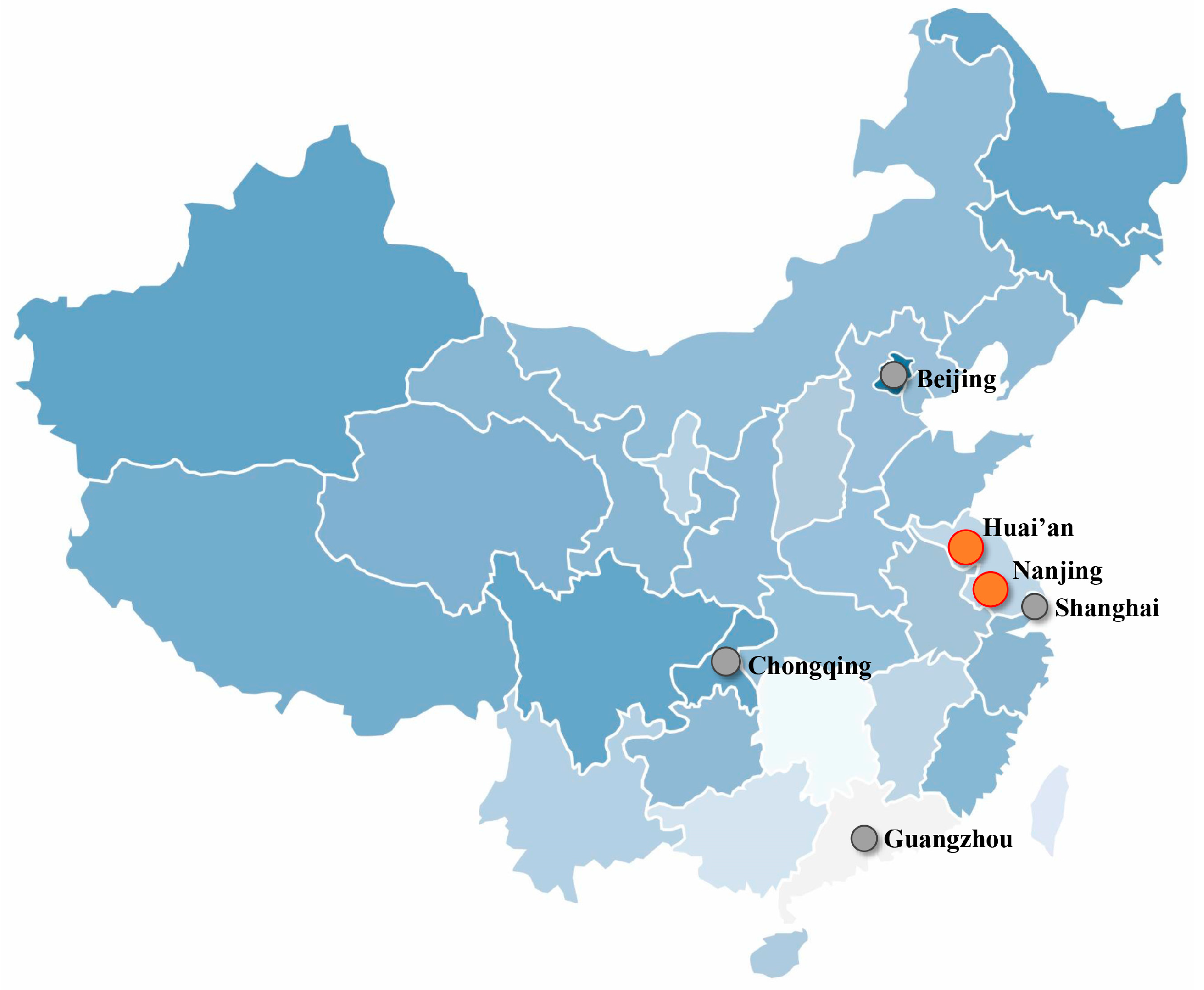

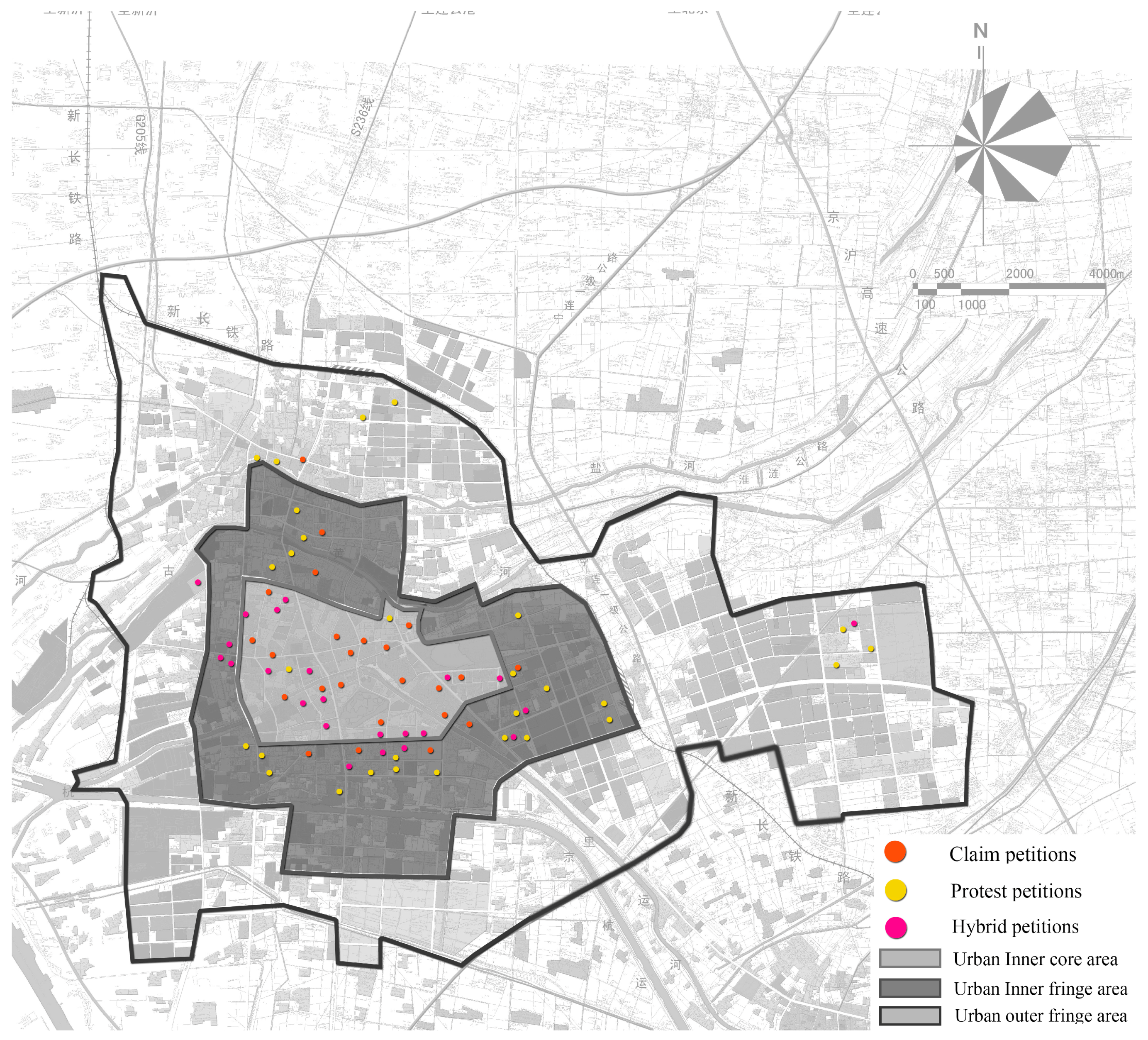
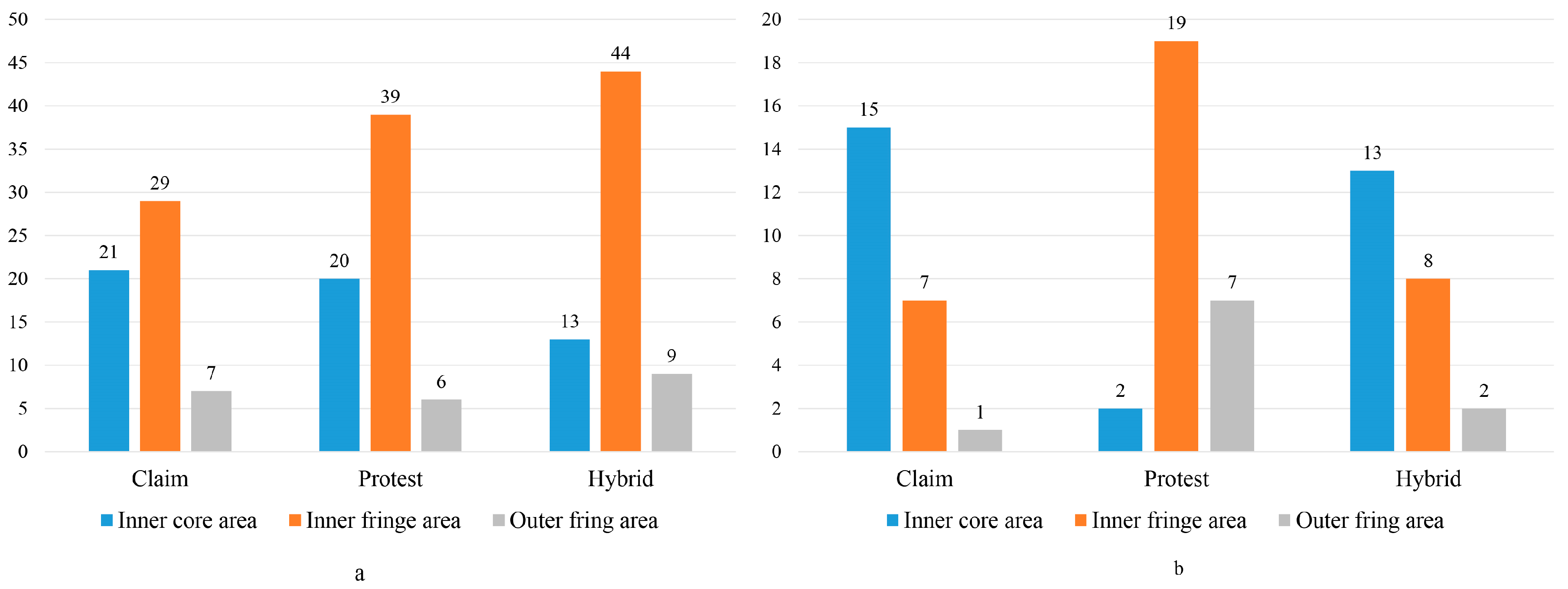
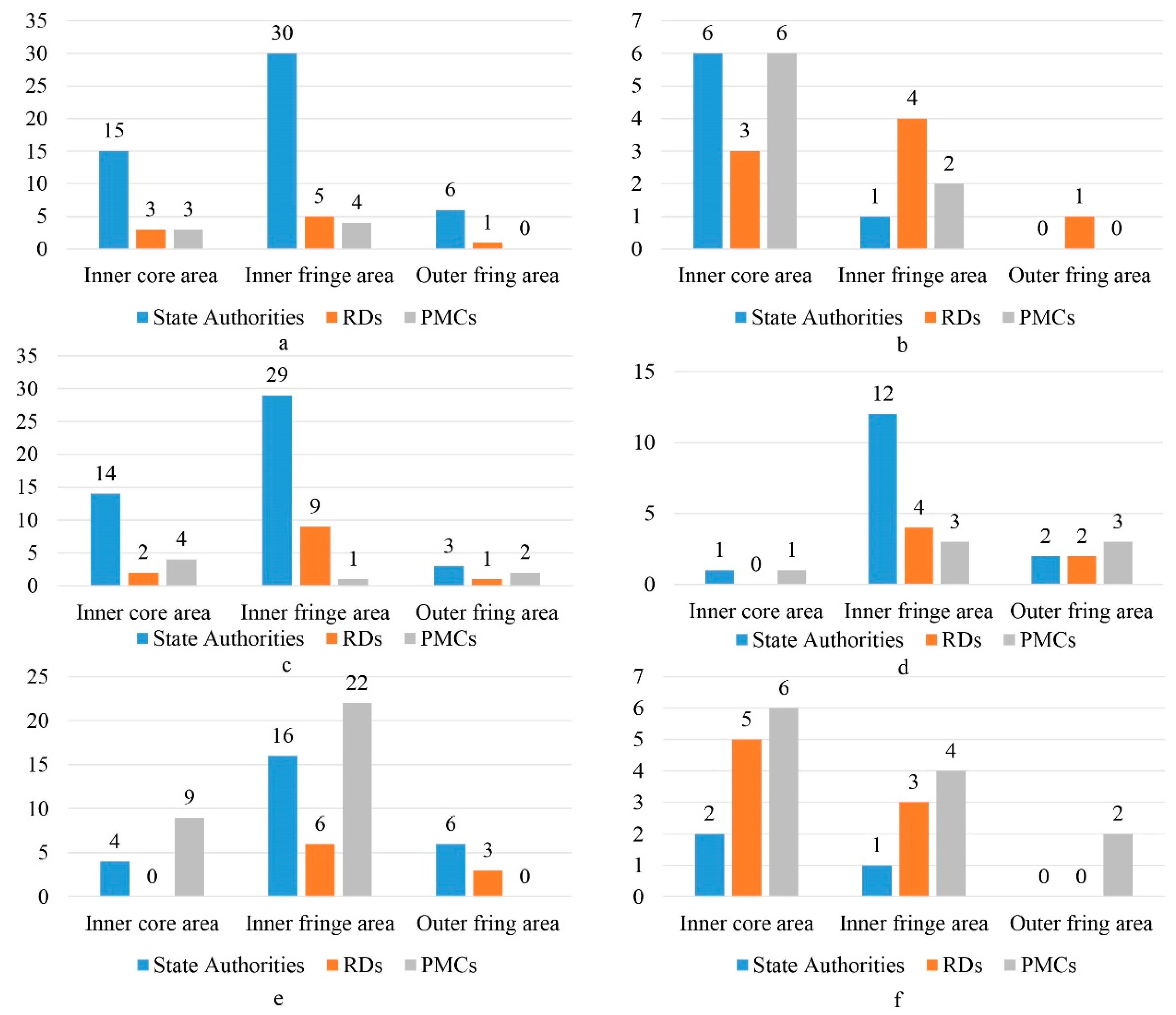
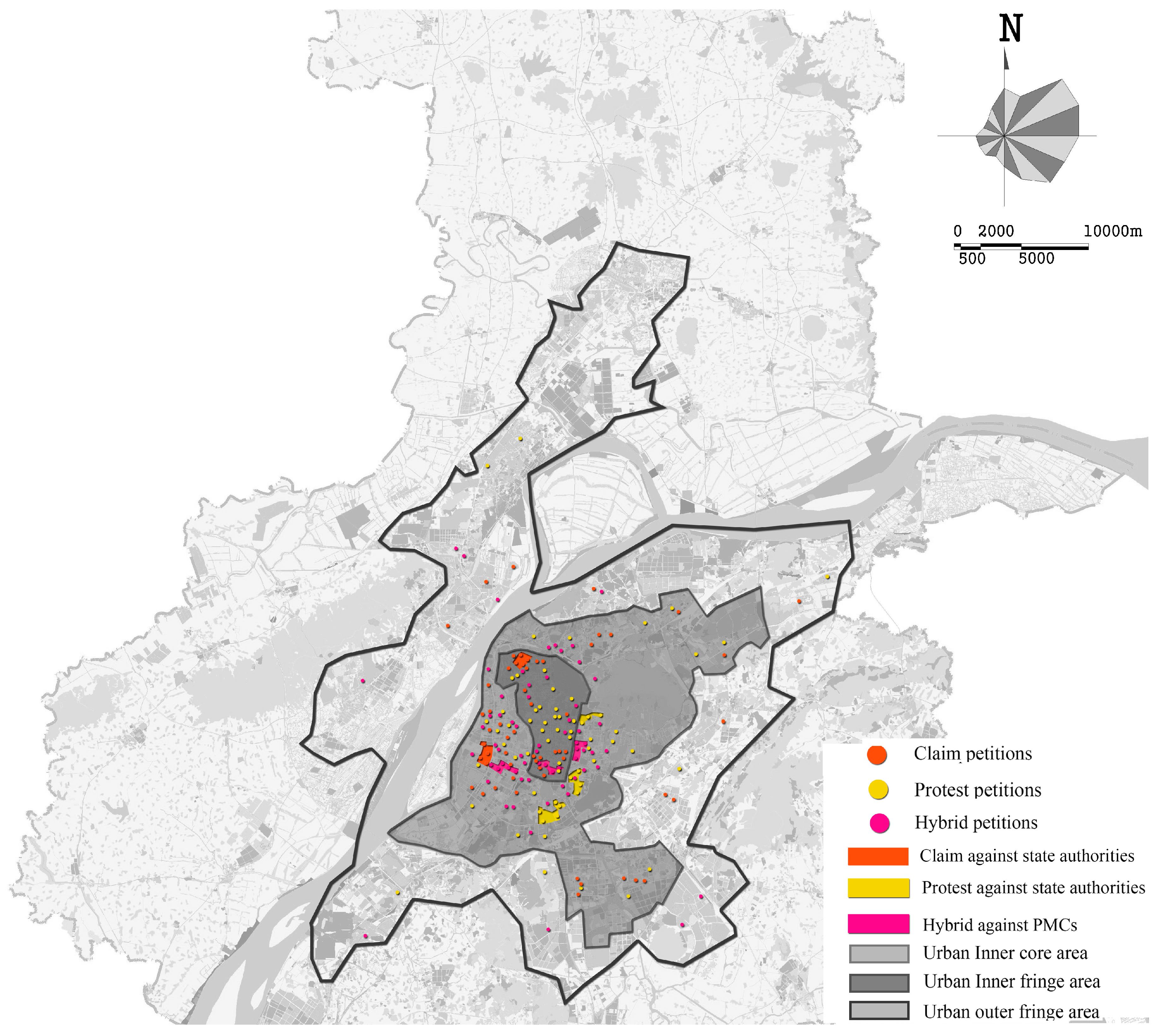
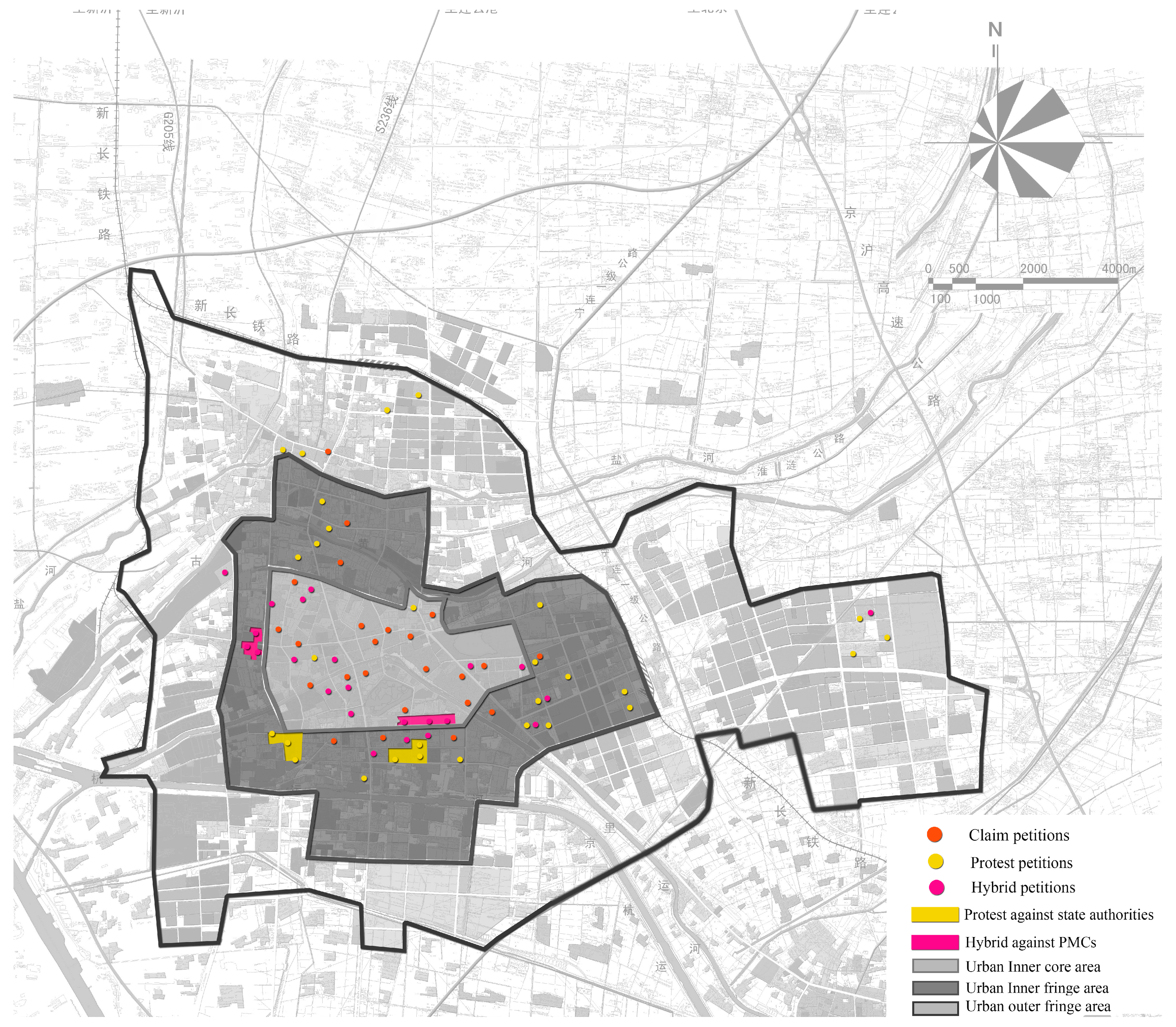
| Categories of City Contexts | Nanjing | Huai’an |
|---|---|---|
| Territorial Area (Km2) | 6622.45 | 10,072.03 |
| Urban Administrative Area (Km2) | 653 | 330 |
| Municipal Population (M) | 8.19 | 3.83 |
| Urban Population (M) | 5.41 | 1.66 |
| City Hierarchy (2016) | Second-tier | Third-tier |
| City GDP in 2016 (Billion RMB) | 10,503.02 | 3048 |
| 2013 | 2014 | 2015 | Annual Average Changing Rate | |
|---|---|---|---|---|
| Nanjing | ||||
| All petitions (amounts) | 113 | 121 | 135 | 6.1% |
| (proportions) | 100% | 100% | 100% | |
| Petitions in urban neighborhoods (amounts) | 71 | 89 | 99 | 11.7% |
| (proportions) | 62.8% | 73.6% | 73.3% | |
| Targeted petitions (amounts) | 49 | 62 | 77 | 16.3% |
| (proportions) | 43.4% | 51.2% | 57.1% | |
| Huai’an | ||||
| All petitions (amounts) | 65 | 66 | 70 | 2.5% |
| (proportions) | 100% | 100% | 100% | |
| Petitions in urban neighborhoods (amounts) | 31 | 39 | 45 | 13.2% |
| (proportions) | 47.7% | 59.1% | 64.3% | |
| Targeted petitions (amounts) | 19 | 24 | 31 | 17.7% |
| (proportions) | 29.2% | 36.4% | 44.3% | |
| 2013 | 2014 | 2015 | Annual Changing Rate | |
|---|---|---|---|---|
| Nanjing | ||||
| Claim (amount) | 12 | 19 | 26 | 29.4% |
| (proportion) | 24.5% | 30.7% | 33.8% | 11.3% |
| Protest (amount) | 21 | 23 | 19 | −3.3% |
| (proportion) | 42.9% | 37.1% | 24.7% | −16.8% |
| Hybrid (amount) | 16 | 20 | 32 | 26.0% |
| (proportion) | 32.6% | 32.2% | 41.5% | 8.4% |
| Huai’an | ||||
| Claim (amount) | 5 | 8 | 10 | 26.0% |
| (proportion) | 26.4% | 33.3% | 32.3% | 7.0% |
| Protest (amount) | 7 | 9 | 12 | 19.7% |
| (proportion) | 36.8% | 37.5% | 38.7% | 1.6% |
| Hybrid (amount) | 7 | 7 | 9 | 8.7% |
| (proportion) | 36.8% | 29.2% | 29.0% | −7.6% |
| Year | Petition Counterparties | ||||
|---|---|---|---|---|---|
| State Authorities | Real Developers | PMCs | |||
| Nanjing | |||||
| 2013 | Claim | % | 83.3 | 8.3 | 8.3 |
| Protest | % | 76.2 | 14.3 | 9.5 | |
| Hybrid | % | 37.5 | 25.0 | 37.5 | |
| Total | % | 65.3 | 16.3 | 18.4 | |
| 2014 | Claim | % | 73.7 | 15.8 | 10.5 |
| Protest | % | 68.0 | 20.0 | 12.0 | |
| Hybrid | % | 38.9 | 11.1 | 50.0 | |
| Total | % | 68 | 16.1 | 22.6 | |
| 2015 | Claim | % | 68.0 | 25.0 | 12.0 |
| Protest | % | 68.4 | 21.1 | 10.5 | |
| Hybrid | % | 40.6 | 9.4 | 50.0 | |
| Total | % | 56.6 | 15.8 | 27.6 | |
| Huai’an | |||||
| 2013 | Claim | % | 40.0 | 20.0 | 40.0 |
| Protest | % | 57.1 | 14.3 | 28.6 | |
| Hybrid | % | 14.3 | 28.6 | 57.1 | |
| Total | % | 36.8 | 21.1 | 42.1 | |
| 2014 | Claim | % | 37.5 | 25.0 | 37.5 |
| Protest | % | 44.4 | 22.2 | 33.3 | |
| Hybrid | % | 14.3 | 42.9 | 42.9 | |
| Total | % | 33.3 | 29.2 | 37.5 | |
| 2015 | Claim | % | 20.0 | 50.0 | 30.0 |
| Protest | % | 58.3 | 25.0 | 16.7 | |
| Hybrid | % | 11.1 | 33.3 | 55.6 | |
| Total | % | 32.3 | 35.5 | 32.3 | |
| Ages of Urban Neighborhoods 1 | Petition Counterparty | Housing Size | Households Involved | ||
|---|---|---|---|---|---|
| Nanjing | |||||
| Petition type | Pearson Correlation | 0.240 ** | 0.346 ** | 0.020 | 0.299 ** |
| Sig. (2-tailed) | 0.001 | 0.000 | 0.787 | 0.000 | |
| Huai’an | |||||
| Petition type | Pearson Correlation | 0.237 * | 0.164 | 0.155 | 0.353 ** |
| Sig. (2-tailed) | 0.042 | 0.164 | 0.189 | 0.002 | |
| Petition Type 1 | Beta | Standard Error | Sig. 2 | ||
|---|---|---|---|---|---|
| Nanjing | |||||
| Protest | Ages of urban neighborhoods | Pre-1998 | 0.466 | 0.491 | 0.342 |
| 1999–2008 | 0.033 | 0.521 | 0.949 | ||
| After 2009 | −0.918 | 0.547 | 0.093 | ||
| Households Involved | 0.021 | 0.009 | 0.015 | ||
| Hybrid | Ages of urban neighborhoods | Pre-1998 | −1.960 | 0.638 | 0.002 |
| 1999–2008 | 0.455 | 0.483 | 0.346 | ||
| After 2009 | −1.266 | 0.563 | 0.025 | ||
| Households Involved | 0.037 | 0.009 | 0.000 | ||
| Huai’an | |||||
| Protest | Ages of urban neighborhoods | Pre-1998 | 0.031 | 0.687 | 0.964 |
| 1999–2008 | 1.301 | 0.843 | 0.123 | ||
| After 2009 | −0.886 | 0.867 | 0.307 | ||
| Households Involved | 0.020 | 0.016 | 0.043 | ||
| Hybrid | Ages of urban neighborhoods | Pre-1998 | −2.214 | 1.191 | 0.049 |
| 1999–2008 | 1.567 | 0.847 | 0.065 | ||
| After 2009 | −1.876 | 0.987 | 0.050 | ||
| Households Involved | 0.040 | 0.018 | 0.027 | ||
© 2018 by the authors. Licensee MDPI, Basel, Switzerland. This article is an open access article distributed under the terms and conditions of the Creative Commons Attribution (CC BY) license (http://creativecommons.org/licenses/by/4.0/).
Share and Cite
Tang, L.; Zhou, F.; Feng, X.; Luo, Y. Collective Civic Petitions in Urban Neighborhoods: A Comparative Study between Two Different-Tier Chinese Cities. Sustainability 2018, 10, 4660. https://doi.org/10.3390/su10124660
Tang L, Zhou F, Feng X, Luo Y. Collective Civic Petitions in Urban Neighborhoods: A Comparative Study between Two Different-Tier Chinese Cities. Sustainability. 2018; 10(12):4660. https://doi.org/10.3390/su10124660
Chicago/Turabian StyleTang, Le, Fengqin Zhou, Xueliang Feng, and Yali Luo. 2018. "Collective Civic Petitions in Urban Neighborhoods: A Comparative Study between Two Different-Tier Chinese Cities" Sustainability 10, no. 12: 4660. https://doi.org/10.3390/su10124660
APA StyleTang, L., Zhou, F., Feng, X., & Luo, Y. (2018). Collective Civic Petitions in Urban Neighborhoods: A Comparative Study between Two Different-Tier Chinese Cities. Sustainability, 10(12), 4660. https://doi.org/10.3390/su10124660




